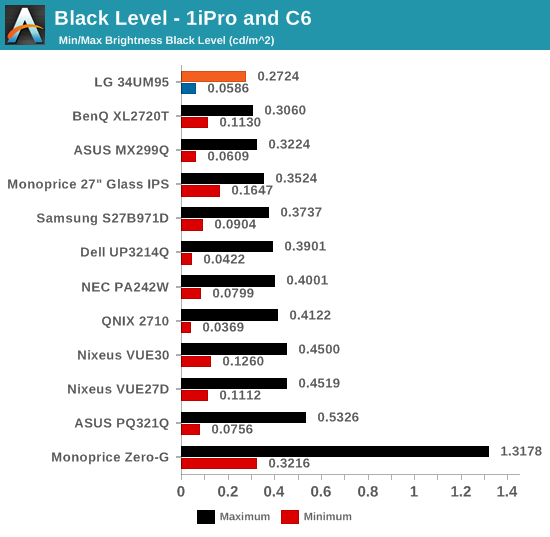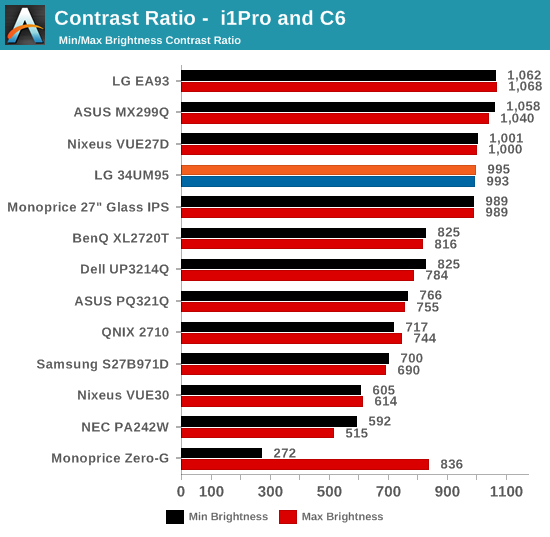LG 34UM95 Monitor Review
by Chris Heinonen on June 18, 2014 7:00 AM ESTAll measurements are done using CalMAN 5.3 from SpectraCal and a custom workflow. An i1Pro and C6 meters are used to measure accurate colors and low light levels. For all test patterns I use APL 50% when possible to prevent backlight tricks and other things from skewing the results. Full field test patterns are used with the display uniformity testing.
With the backlight set to minimum the LG 34UM95 puts out 55 cd/m2 of light. That is a good number that is low enough to work for any dark environment, but not so low that you can’t use it. The brightness control operates in 1% steps giving you lots of room for adjustment. The maximum light level is 270 cd/m2. This is a bit lower than I would like to see, as direct sunlight will still wash things out, but it is decent. Most people likely will pick a setting in the middle of these and the brightness adjustment makes it easy to get the level you want.

Black levels are also very good. The minimum black level achieved is 0.0586 cd/m2 and the maximum level is 0.2724 cd/m2. The 21:9 monitors have been very good so far at getting low black levels and the 34UM95 is no exception.

These combine to give us a contrast ratio very close to 1,000:1. As this is now what I consider to be acceptable in a good IPS display, the LG 34UM95 does not disappoint.

So far, so good for the 34UM95. Let's move on to the color accuracy.










110 Comments
View All Comments
nathanddrews - Wednesday, June 18, 2014 - link
My solution is simply not to scale anything. Every 4K monitor I've tested out so far (including the UP2414Q) has been great at 1:1. From my experience so far, either people are overhyping the scaling issue or they need glasses. I'm not saying that to be a d!ck - I've got glasses and can see everything clearly with them on.twistedgamez - Thursday, June 19, 2014 - link
this 100%, i can understand some people increasing the page zoom setting bit a little on chrome for example, but there is no reason the UI elements, url bar and any other stuff needs to be zoomed - i love my 2880x1800 at nativecheinonen - Thursday, June 19, 2014 - link
I have the 24" NEC EA244UHD here right now, and without scaling enabled it's unusable to me. Text elements are just too small to read from my regular seated distance so I have to use scaling with it. The 32" 4K monitors have been semi-usable without scaling but the 24" ones just are not IMO.fokka - Wednesday, June 18, 2014 - link
5k is just awkward. 4k content will be upscaled and future 8k will be very much downscaled.same with this model, just with 1080p and 4k.
if you need such an awkward screen for your workflow, go ahead, but for movies it doesn't seem to be ideal.
acejj26 - Wednesday, June 18, 2014 - link
I'm pretty sure 1720:1440 is more of a 7:6 ratio, not 6:5.Death666Angel - Wednesday, June 18, 2014 - link
1720/1440 = 1.194447/6 = 1.16667
6/5 = 1.2
Pretty sure 1.19 is closer to 1.2 than to 1.17. :)
acejj26 - Wednesday, June 18, 2014 - link
1. Too early for me to post my post...no caffeine yet2. Then this isn't a 21:9 monitor, since if it were, each half of the monitor would be 21:18 (7:6)
3. This is nitpicking to the extreme
JarredWalton - Wednesday, June 18, 2014 - link
I wonder if there's a typo on the specs and it's not really 3440 pixels wide? Technically, 21:9 with a 1440 height should be 3360 pixels wide. It's not like 1440 isn't easily divisible by 9 (it's 160), and 3440 doesn't really have any particular importance. I guess you just get a "free" 80 extra pixels in width (again, assuming it's not an error on the spec sheets).Of course, the 2560x1080 displays aren't 21:9 either. The correct resolution for 21:9 would be 2520x1080, so there customers are "gaining" 40 pixels of width. 2560 as a width at least makes sense, though, as there have been lots of 2560x1600/2560x1440 displays. There ought to be some logical reason for the choice of resolution, so perhaps there's a technical aspect to the displays that makes the slightly odd AR easier/cheaper to manufacture. However, I can't think of what that reason would be, at least not for a 3440 width.
DanNeely - Wednesday, June 18, 2014 - link
I don't know why they fudged the width/aspect ratio slightly either; but Google reports a number of companies launching 3440x1440 monitors but nothing at 3360x1440. Possibly the extra width lets them reuse existing production lines, just cutting at different points, with less wastage.japtor - Wednesday, June 18, 2014 - link
I figure they're sticking with the "21:9" terminology for marketing reasons, like it's easy to compare it to the usual 16:9 screens in that sense.